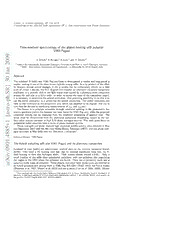Table Of Contento
Comm.in Asteroseismology,N 159, 2009
ProceedingsoftheJENAM2008SymposiumNo 4: AsteroseismologyandStellarEvolution
Time-resolved spectroscopy of the planet-hosting sdB pulsator
V391Pegasi
9
0
0 S.Schuh,1 R.Kruspe,1 R.Lutz,1 andR.Silvotti2
2
1Institutfu¨rAstrophysik,Universit¨atGo¨ttingen,Friedrich-Hund-Platz1,37077Go¨ttingen,Germany
n 2INAF-OsservatorioAstronomicodiCapodimonte,viaMoiariello16,80131Napoli,Italy
a
J
Abstract
0
3
The subdwarf B (sdB) star V391 Peg oscillates in short-period p modes and long-period g
modes,makingitoneofthethreeknownhybridsamongsdBs. Asaby-productoftheeffort
]
R to measure secular period changes in the p modes due to evolutionary effects on a time
scaleofalmostadecade, theO–Cdiagramhasrevealedanadditional sinusoidal component
S attributed to aperiodic shiftinthe lighttravel time caused by a planetary-masscompanion
. around the sdB star in a 3.2yr orbit. In order to derive the mass of the companion object,
h
itisnecessary todetermine theorbital inclination. Onepromising possibilitytodothisisto
p
use the stellar inclination as a primer for the orbital orientation. The stellar inclination can
-
o refer to the rotational or the pulsational axis, which are assumed to be aligned, and can in
r turnthen bederivedbycombiningmeasurements ofvrot andvrotsini.
t The former is in principle accessible through rotational splitting in the photometric fre-
s
quency spectrum(whichhashowevernotbeenfoundforV391Pegyet),whiletheprojected
a
rotational velocity can be measured from the rotational broadening of spectral lines. The
[
latter must be deconvolved from the additional pulsational broadening caused by the sur-
1 face radial velocity variation inhigh S/N phase averaged spectra. This work giveslimitson
v pulsational radialvelocitiesfromaseriesofphaseresolvedspectra.
5 Phaseaveraged andphase resolved highresolution echelle spectra wereobtained inMay
8 andSeptember2007withthe9m-classHobby-EberlyTelescope(HET),andonephaseaver-
8 agedspectrum inMay2008withthe10m-Keck1telescope1.
4
IndividualObjects: V391Pegasi
.
1
0 The hybrid pulsating sdB star V391 Pegasi and its planetary companion
9
0 Subdwarf B stars (sdBs) are subluminous, evolved stars on the extreme horizontal branch
: (EHB). They have a He burning core but, due to previous significant mass loss, no H-
v
shell burning in their thin hydrogen shells. Their masses cluster around 0.5M⊙. Only a
i
X small fraction of the sdBs show pulsational variations, with non-pulsators also populating
the region in the HRD where the pulsators are found. There are p (pressure) mode and g
r
(gravity)modetypesofpulsation. Threeobjects thatshowbothmodetypesarereferredto
a
as hybrid pulsators and among them is V391Peg (HS2201+2610) which has five p modes
(Østensenetal.2001;Silvottietal.2002)andonegmode(Lutzetal.2008,2009). Silvotti
1
DataobtainedwiththeHobby-EberlyTelescope(jointprojectofUofTexas,PennsylvaniaStateU,StanfordU,U
Mu¨nchen,UGo¨ttingen)andtheW.M.KeckObservatory(operatedbyCalTech,UofCalifornia,NASA),madepossibleby
thegenerousfinancialsupportoftheW.M.KeckFoundation.
2 Time-resolvedspectroscopyoftheplanet-hostingsdBpulsatorV391Pegasi
Figure1: RadialvelocitiesderivedfortheHβ(squares),Hγ andHδ(trianglesanddiamonds)linesfrom
crosscorrelationwiththetemplate(witherrorbars,andplottedatasmallphaseoffsetforclarity); and
weightedmeanoftheresults(crossesandthickerrorbars)togetherwithaconstantandasinusoidalcurve.
et al. (2007) detected parabolic and sinusoidal variations in the observed–calculated (O–C)
diagram constructed for the two main pulsation frequencies at 349.5s and 354.2s over the
observingperiodofsevenyears. Thesinusoidalcomponent isattributed tothepresenceofa
verylow-masscompanion (V391Pegb,msini =3.2±0.7MJup). Thedetermination of the
true massofthis’asteroseismic planet’ requiresaconstraint ontheorbital inclination which
canpresumablybedetermined viathestellarrotational inclination.
Limits on the pulsational radial velocities from phase resolved echelle spectra
Echelle spectra of V391Peg were taken during May and September 2007 with the HRS
(R = 15000) of the HET at the McDonald Observatory, and with HIRES (R =31000) at
the Keck 1 telescope atop Mauna Kea in May 2008. Data reduction was done with ESO-
Midasusingstandardprocedures. Individualechelleordersweremergedandthefinalspectra
were carefully normalized and finally summed (Kruspe 2009, diploma thesis, in prep.). This
resultsinasetofindividualspectra (S/N ≈3),inparticulartwoSeptember 2007hightime
resolution series,andsummedspectra forMayandSeptember 2007.
Inourattemptto“clean”therelevantrotationalbroadeningfrompulsationaleffects,the
spectrainSeptemberobtainedintimeresolvedmodewerecombinedtoaseriesoftenphase
resolved averaged spectra (S/N ≈ 9) for the main pulsation period of 349.5s (similar to
Tillichetal.2007).
Thecross-correlationofthisseriesofaveragedspectrawithapurehydrogenNLTEmodel
spectrumatTeff =30000Kandlog(g/cms−2)=5.5asatemplateyieldspulsationalradial
velocity measurements as shown in Fig. 1 for the different Balmer lines. The maximum
amplitude ofasinusoidal curve (fixedatthe expected period) thatcould beaccommodated
incomparison to the weighted means ofthe Balmer linesrevealsthat any pulsational radial
velocityamplitudeissmallerthantheaccuracyofourmeasurementsandconfirmstheupper
limitof16kms−1 givenbyKruspeetal.(2009).
The resolution of the model template matches the spectral resolution of the (pulsation-
averaged)Keckspectrum. AcomparisonoftheHαNLTElinecoreshapeyieldsanevenmore
stringentupperlimitforthecombinedbroadeningeffectofpulsationandrotationofatmost
9kms−1. This means that much better data in terms of spectral resolution and signal to
noisewillbenecessary tomeasurevpuls andvrotsini.
S.Schuh,R.Kruspe,R.Lutz,andR.Silvotti 3
Acknowledgments. TheauthorsthankA.ReinersandG.BasriforprovidingtheKeckspec-
trum,H.EdelmannforassistanceinobtainingtheHETspectra,andU.HeberandT.Rauch
for providing grids of model spectra. This work has benefited from the help, advice and
softwarebyI.Traulsen. WealsothanktheconferencesponsorsandinparticularHELAS(Eu-
ropeanHelio-andAsteroseismologyNetwork,anEuropeaninitiativefundedbytheEuropean
Commission since April 1st, 2006, as a ”Co-ordination Action” under its Sixth Framework
Programme FP6) and the Astronomische Gesellschaft for financially supporting the poster
presentation atJENAM2008MinisymposiumN◦ 4through travelgrantstoS.S.andR.L.
References
Kruspe,R.,Schuh,S.,Silvotti,R.,&Traulsen,I.2008,CoAst,157,325
Lutz,R.,Schuh,S.,Silvotti,R.,etal.2008,ASPConf.Ser.,392,339
Lutz,R.,Schuh,S.,Silvotti,R.,etal.2009,A&A,inpress,arXiv:0901.4523
Østensen,R.,Solheim,J.-E.,Heber,U.,etal.2001,A&A,368,175
Silvotti,R.,Janulis,R.,Schuh,S.,etal.2002,A&A,389,180
Silvotti,R.,Schuh,S.,Janulis,R.,etal.2007,Nature,449,189
Tillich,A.,Heber,U.,O’Toole,S.J.,etal.2007,A&A,473,219

